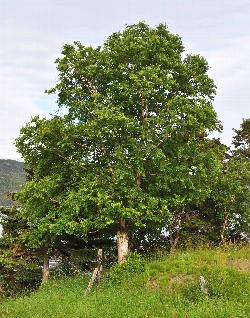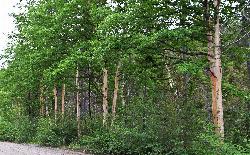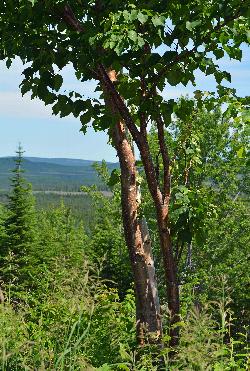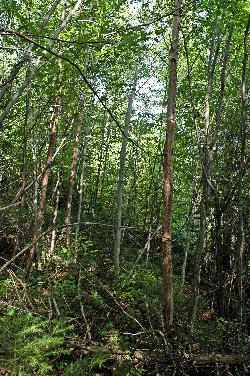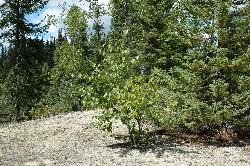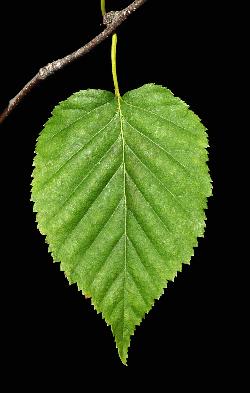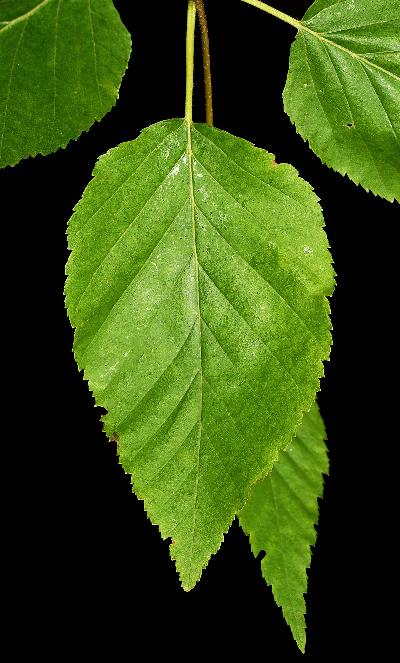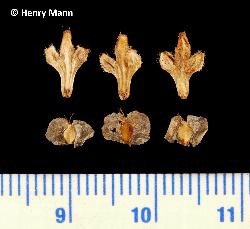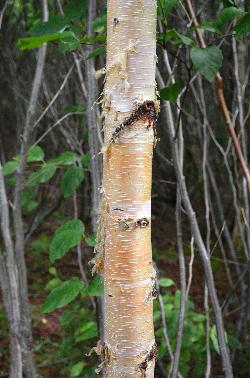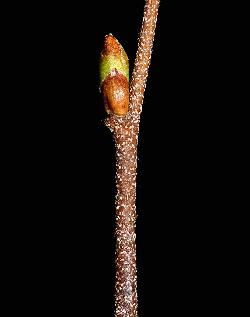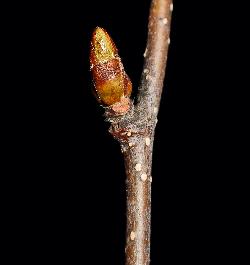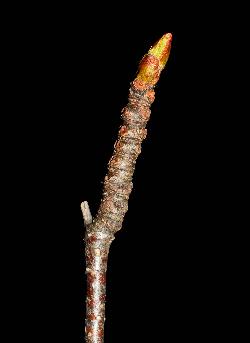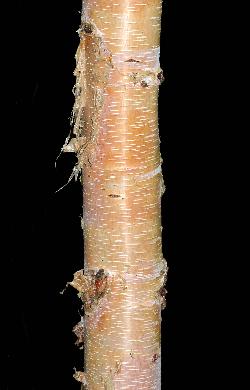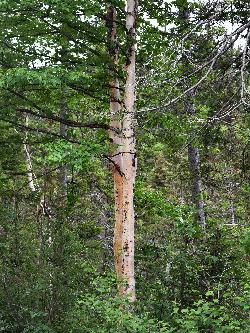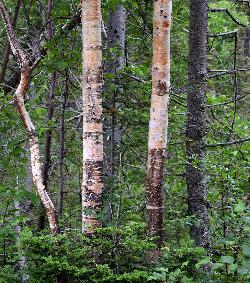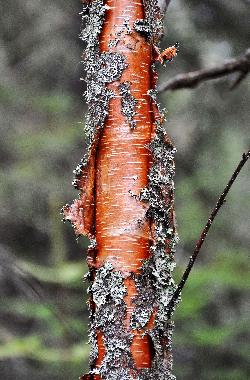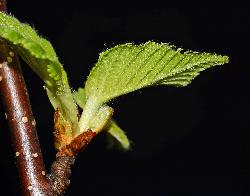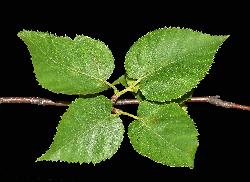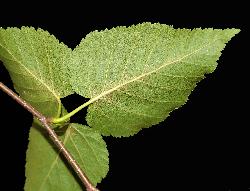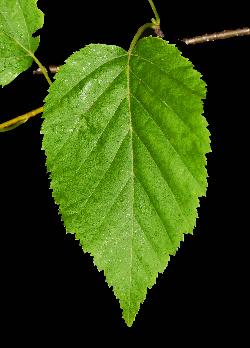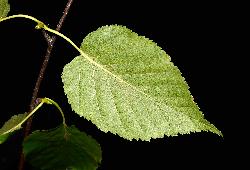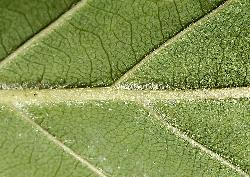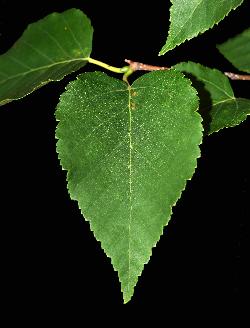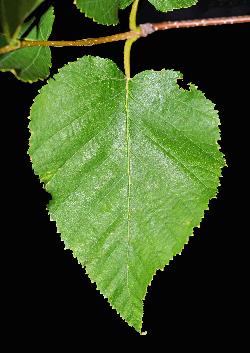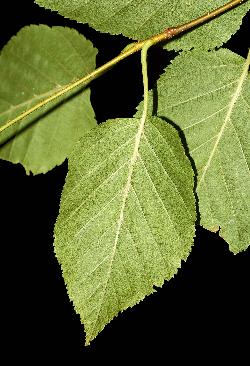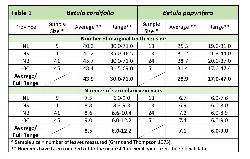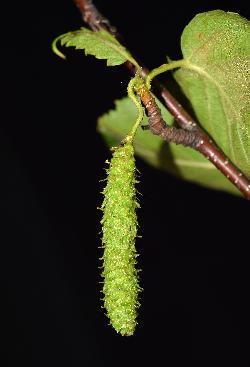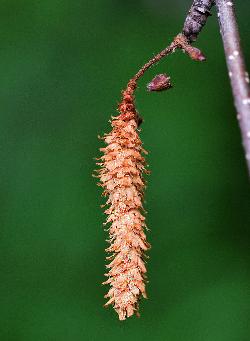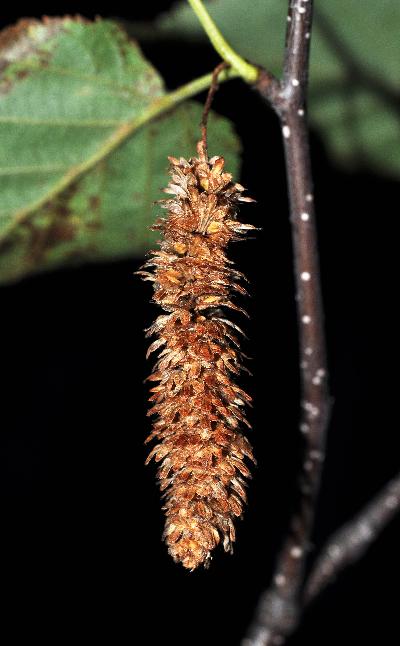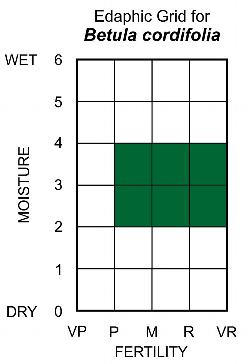Fr: bouleau à feuilles cordées, bouleau cordifolié
IA: innikuai, innishkuai
Betulaceae - Birch Family
Note: Numbers provided in square brackets in the text refer to the image presented above; image numbers are displayed to the lower left of each image.
General: A medium-sized deciduous tree, with spreading to ascending branches [1–5]; heartleaf birch is usually 20–25 m tall, with an average d.b.h. of 70 cm (up to 102 cm), and a life span that exceeds 200 years (Safford et al. 1990). Heartleaf birch has a slower growth rate than white birch, but eventually equals or exceeds the height and age of white birch (Brittain and Grant 1965b). Since 1945, heartleaf birch was usually treated as a variety of white birch (Fernald 1945), as Betula papyrifera Marshall var. cordifolia (Regel) Fernald). However, later researchers recommended it be treated at the rank of species (Brittain and Grant 1967a, 1967b; Grant and Thompson 1975), but these studies were largely overlooked until the Flora of North America treated Betula cordifolia as distinct from B. papyrifera (Furlow 1997). Grant and Thompson (1975) also point out that the common name 'mountain white birch' is a misnomer, as B. cordifolia "may actually be more common in maritime areas with cooler summers," rather than being restricted to alpine regions.
Key Features:
- Leaves generally have cordate leaf bases [6], but trees growing in maritime areas are more likely to have rounded bases [7].
- Leaves usually have 9–12 pairs of secondary veins, but may have as few as 6 pairs; they also have an average of 40–48 teeth (or more) on each margin [6–7].
- The pistillate scales that subtend the fruit have a blunt central lobe with nearly parallel sides, the two lateral lobes extend forward and outward (porrect) and are shorter than the central lobe; also, the thin wings of the fruit are each much broader than the nutlet [8]. Note that in image 9, the central lobes of the scales on either end of the row have their edges curled under slightly, making them appear narrower than normal.
- The bark of heartleaf birch is off-white to bronzy coloured and peels in very thin, narrow strips rather than sheets [9].
Stems/twigs: Twigs are reddish brown, usually glabrous to sparsely pubescent, with pale elliptic lenticels [10] and immature twigs bear numerous resin glands [11]; twigs have no odour or taste of wintergreen when broken or chewed. Brittain and Grant (1967a) noted that young stems of heartleaf birch retain remnants of the cuticle for some time as the bark develops [12]. Birch trees have two types of shoots: long shoots and spur shoots. Long shoots are new terminal growth with alternate lateral buds that are 4–6 mm long, ovate, blunt (obtuse), resinous, and have three 2-toned scales that are greenish to light brown towards the base and darker brown towards the apex [13]. Spur shoots are short lateral shoots that occur on 1- and 2-year-old twigs and bear a single bud with 4–6 bud scales [14–15]. Each year, spur shoots produce 2–3 leaves and a very short internode, thus counting the rows of bud scales scars indicates the age of each spur shoot. Leaf scars are elliptic with 3 bundle trace scars. The bark on young trees and branches is dark reddish-brown to black and glabrous with small pale lenticels. Mature trees have an off-white to bronze coloured outer bark that separates in thin shaggy strips [16–18]; the inner bark is pinkish to copper coloured [19]; lenticels are prominent, whitish, horizontal, long, and narrow.
Leaves: Alternate, simple, pinnately-veined, and petiolate. Leaves are ovate to cordate, firm, pubescent when young, with numerous resin glands, and measure 6–12 cm long by 4–8 cm wide [20]. Long shoots produce a single leaf at each node, while spur shoots have 2–3 leaves and may also produce female catkins [21–23]. On mature leaves, the upper surface is dull and glabrous, with numerous small resinous blotches [24]; the lower surface is slightly paler, with short white to pale brown hairs along the veins and in veins axils [25–26]. The apex is pointed (acute to acuminate), margins are biserrate, often with 2–4 smaller teeth on each larger tooth, and bases are usually cordate [27–28]. But some trees in coastal maritime areas are less likely to have strictly cordate leaf bases (Grant and Thompson 1975), prompting those researchers to conclude that the presence of cordate leaves alone is not a reliable trait to differentiate B. cordifolia from B. papyrifera. Grant and Thompson (1975) describe a "maritime form," of B. cordifolia that often has leaves with rounded or truncate leaf bases [7, 29], as well as cordate bases.
The number of pairs of secondary veins in heartleaf birch is usually 9–12, but according to Brittain and Grant (1965b), the number of secondary veins can range from 6 to 12 pairs, and varies across the range of this species. Counts from a limited sample (5 leaves) of Betula cordifolia from Newfoundland by Grant and Thompson reported a range of 6–9 pairs of secondary veins, with an average of 8.5 pairs, while examination of 45 Betula cordifolia leaves from Québec showed a range of 6–12 vein pairs, with an average of 7.1 pairs (Grant and Thompson 1975). However, leaves of heartleaf birch that we examined in Newfoundland and the Algoma District of Ontario both showed a range of 9–12 pairs of secondary veins. The smaller average number of vein pairs reported by Grant and Thompson may be explained either by their limited sample size (5 leaves) or by the location of their samples, which were from lower elevation sites, while leaves that we examined were from Rocky Harbour and higher elevations behind Pasadena in western Newfoundland, and from North West River in Labrador.
Another trait of heartleaf birch measured by Grant and Thompson (1975) that varies from Newfoundland to Québec is the number of teeth (serrations) on the leaf margins, with an average of 40–48 teeth per margin. While this regional difference may not be significant, a comparison of the number of marginal teeth is useful for differentiating between B. cordifolia and B. papyrifera. Combining the averages calculated by Grant and Thompson from Newfoundland to Québec, leaves of B. cordifolia had an average of about 44 teeth per margin, compared to an average of about 29 teeth per margin for B. papyrifera. Table 1 [30] shows a summary of leaf trait measurements included in Tables A1–A5 of Grant and Thompson's 1975 publication.
Flowers: Unisexual; trees monoecious, with separate male and female catkins on the same tree and branch. Birch catkins have dense spirals of small flowers subtended by a 3-lobed bract; sepals and petals are lacking. Male flowers occur in pendant elongate catkins, about 5–10 cm long when shedding pollen; the flowering catkins emerge from cylindrical overwintering catkins, 1–3 cm long, located at the ends of long shoots. Bracts (staminate scales) of the male catkins subtend 3 flowers, each with 2–3 stamens. Pollination is by wind (anemophily). Female flowers are numerous in erect narrowly cylindrical catkins, about 1–2 cm long, and emerge with the leaves from spur shoot buds. Each 3-lobed bract (pistillate scale) subtends 2–3 female flowers, composed of a single pistil with a 2-carpelled inferior ovary and 2 pinkish to reddish styles, 1.5–2.5 mm long.
Fruit: Fruiting catkins [31–33] are pendant, cylindrical, 2.5–5.5 cm long by up to 1.0 cm wide, and composed of numerous small bracts (pistillate scales), 5.5–8 mm long, which subtend the small fruit (winged nutlets). The nutlets are about 2.75 mm long by 2 mm wide, with thin papery wings that are much wider and longer than the body of the nutlet; the nutlets are each subtended by a 3-lobed pistillate scale with a comparatively long blunt central lobe that has ± parallel sides and exceeds the 2 porrect (extending forward and outward) lateral lobes [8] (Brittain and Grant 1967b); scales are shed with the nutlets. Dispersal of fruits and seeds is by wind (anemochory). Heartleaf birch is diploid, with a chromosome number of 2n = 28, although occasional polyploid (2n = 56) individuals, probably of hybrid origin, may occur (Brittain and Grant 1965b, 1967a).
Ecology and Habitat: Heartleaf birch, although often occurring in Newfoundland and Labrador with white birch, appears to be more frequent in cooler maritime and northern locations. It can be abundant as an early succession species after disturbance, but in mature stands it usually occurs in small patches. It may persist as a dominant on the scree slopes in mountainous terrain. Heartleaf birch can occur on a wide range of soil conditions, but grows best on moist nutrient-rich sites. The specifics of its ecology and distribution remain uncertain because of its longstanding treatment as a variety of white birch.
Edaphic Grid: See image [34]: the Edaphic Grid for Betula cordifolia.
Forest Types: Within the forest classification, heartleaf birch is most abundant in the following moist forest types on the Northern Peninsula:
- Abietum clintonietosum (Clintonia-Balsam Fir Forest Subassociation)
- Abietum dryopteretosum (Dryopteris-Balsam Fir Forest Subassociation)
In northern Newfoundland, it is also recorded sporadically throughout the other Abietum subassociations and the Sphagno-Piceetum (Sphagnum-Black Spruce Bog Association). The absence of heartleaf birch from the classification in other regions of the Province does not necessarily mean it is absent, but rather it is probably much less frequent. Within the forest classification, Damman (1963) consistently recognized heartleaf birch as a variety of white birch, following the treatment of Fernald (1950).
Succession: Heartleaf birch is generally shade-intolerant and does not form pure stands within the boreal forest. It can be abundant on recent burns and cutovers, and on unstable scree slopes in mountainous terrain.
Distribution: An eastern North American boreal species, heartleaf birch is generally found in northern habitats or at high elevations, particularly on moist sites (Farrar 1995). Since heartleaf birch had long been treated as a variety of white birch, it was seldom differentiated from white birch, therefore, its distribution throughout the Province has not been clearly defined. On the Island, it is most frequently found in western Newfoundland and on the Northern Peninsula, and extends north to northern Labrador (Furlow 1997). In mainland Canada, it is found in the Atlantic Provinces, Québec, and northeastern and northwestern Ontario. In the United States, it occurs from New England west to northern New York, with disjunct populations further south along the Appalachian Mountains; it also occurs from Michigan to Minnesota, contiguous with its range in Ontario (Furlow 1997).
Similar Species: Heartleaf birch is most similar to white birch (Betula papyrifera Marshall), which can be distinguished by leaves with 7–9 pairs of secondary veins, typically truncate to rounded leaf bases (occasionally cordate), leaf surfaces and twigs mainly lack resin glands, and young shoots are very hairy. White birch has glabrous chalky white bark that exfoliates in relatively thick sheets, compared to the off-white to bronze bark of heartleaf birch. The pistillate scales of white birch have a pointed central lobe equal to or shorter than the diverging lateral lobes.
Yellow birch (Betula alleghaniensis Britton) can be distinguished by the latter's yellowish-bronze to silvery-gray bark, which peels off in small thin curls. Yellow birch twigs have a distinct wintergreen flavour when chewed, which is lacking in both white and heartleaf birch twigs. Also, yellow birch leaves have 12–18 pairs of secondary veins on their obovate leaves, which are widest above the middle.


